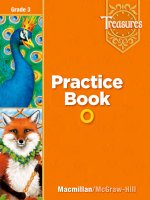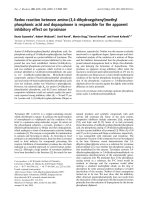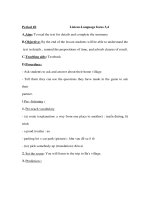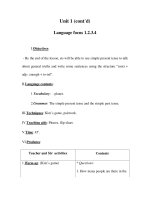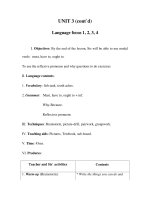Summer Express Between Grade 3 - 4
Bạn đang xem bản rút gọn của tài liệu. Xem và tải ngay bản đầy đủ của tài liệu tại đây (14.36 MB, 142 trang )
BETWEEN
GRADES
&
SuMMER
ExPRESS
Summer Express (between grades 3 & 4) © Scholastic Teaching Resources
3 4
NEW YoRk ∫ToRo
NTo ∫LoNDoN ∫AuckLAND ∫SYDNEY
MExico ciTY ∫NE
W DELhi ∫hoNG koNG ∫BuENoS AiRES
Summer Express (between grades 3 & 4) © Scholastic Teaching Resources
Scholastic Inc. grants teachers permission to photocopy the designated reproducible pages from this book for classroom use. No other part
of this publication may be reproduced in whole or in part, or stored in a retrieval system, or transmitted in any form or by any means,
electronic, mechanical, photocopying, recording, or otherwise, without written permission of the publisher. For information regarding permission,
write to Scholastic Inc., 557 Broadway, New York, NY 10012.
Cover design by Brian LaRossa
Cover photo by www.imagesource.com
Interior illustrations by Robert Alley, Abbey Carter, Maxie Chambliss, Sue Dennen,
Shelley Dieterichs, Jane Dippold, Julie Durrell, Rusty Fletcher, James Hale,
Mike Moran, Sherry Neidigh, Cary Pillo, Carol Tiernon, and Lynn Vineyard
ISBN-13 978-0-545-22693-6 / ISBN-10 0-545-22693-7
Copyright © 2010 by Scholastic Inc. All rights reserved. Printed in the U.S.A.
1 2 3 4 5 6 7 8 9 10
40
16 15 14 13 12 11 10
Dear Parent Letter . . . . . . . . . . . . . . . . . . . . . 4
Terrific Tips for Using This Book . . . . . . . . . . . 6
Week 1 . . . . . . . . . . . . . . . . . . . . . . . . . . . . . 9
Week 2 . . . . . . . . . . . . . . . . . . . . . . . . . . . . 21
Week 3 . . . . . . . . . . . . . . . . . . . . . . . . . . . . 33
Week 4 . . . . . . . . . . . . . . . . . . . . . . . . . . . . 45
Week 5 . . . . . . . . . . . . . . . . . . . . . . . . . . . . 57
Week 6 . . . . . . . . . . . . . . . . . . . . . . . . . . . . 69
Week 7 . . . . . . . . . . . . . . . . . . . . . . . . . . . . 81
Week 8 . . . . . . . . . . . . . . . . . . . . . . . . . . . . 93
Week 9 . . . . . . . . . . . . . . . . . . . . . . . . . . . 105
Week 10 . . . . . . . . . . . . . . . . . . . . . . . . . . 117
Answer Key . . . . . . . . . . . . . . . . . . . . . . . . 129
Certificate . . . . . . . . . . . . . . . . . . . . . . . . . 141
Summer Express (between grades 3 & 4) © Scholastic Teaching Resources
Table of Contents
Congratulations! You hold in your hands an exceptional educational tool that
will give your child a head start into the coming school year.
Inside this book, you’ll find one hundred practice pages that will help your
child review and learn math, reading, writing, grammar, vocabulary, and so
much more! Summer Express is divided into 10 weeks, with two practice
pages for each day of the week, Monday to Friday. However, feel free to use
the pages in any order that your child would like. Here are other features
you’ll find inside:
• A weekly incentive chart and certificate to motivate and reward
your child for his or her efforts.
• Suggestions for fun, creative learning activities you can do with
your child each week.
• A recommended reading list of age-appropriate books that you and
your child can read throughout the summer.
• A certificate of completion to celebrate your child’s accomplishments.
We hope you and your child will have a lot of fun as you work together to
complete this workbook.
Enjoy!
The editors
Summer Express (between grades 3 & 4) © Scholastic Teaching Resources
Dear Parent:
1
5
Pick a good time
for your child
to work on the
activities. You
may want to do
it around midmorning, or early
afternoon when your
child is not too tired.
Encourage
your child
to complete the
worksheet, but
don’t force the
issue. While you
may want to
ensure that your
child succeeds, it’s
also important that your child
maintain a positive and relaxed attitude
toward school and learning.
ld own
ou ca t g t
as h re
Comp
le
a l sha e the cha
rt
rks w
i e all wi h he nam
e of
1 he
he cor
a ges
ect sha
t shark
rk
2 the
sma
7 has
a
8 has
a
9 hav
e
u
HE
SKY L
OC
12 has
ea
3
’s lncentiv
ame H re
e Ch
art: Week
1
At the beginning
of each week,
discuss with your
child how many
minutes a day he or
Congratulatio
ns!
1
she would like to
read. Write the goal
at the top of the
incentive chart for the week.
(We recommend that a child entering
fourth grade read 20 to 25 minutes a day.)
This wee
k l plan to
read
CH RT YOUR P
ROG ESS
H RE
Week 1
l read for
D y1
m nutes
Day 2
m nutes
minutes eac
h day
Day 3
minutes
Day 4
minutes
Put a st cker
o show you
comp eted
ea h
day s work
#
Wow! You d d
a great j
ob th s
Day 5
minutes
week!
l ce
s i ker e
e
Parent or
Careg ver’
s S gnature
Reward your child’s efforts
with the small stickers
at the end of each day. As an
added bonus, let him or her
affix a large sticker at the
bottom of the incentive chart
for completing the activities
each week.
whale
shark
er
ns of
car i age
harp-p
ointed
shaped
spear
com ng
out of
i s hea
like a
d
hamme
r
scales
hard
nd b te
ma k
ike a
aw
en uno
pened
s and
cans
boat
cush
ons
R ad mo
e abo
sim l
r ties and ut wo d f
er nt
two d
ki ds
ff ren
of shar
es
ks On
not er
she
c ock
30
2
4
ske eto
head
kin of
sp ky
10 ea
es a rou
11 ook
s
9
a
sw mm
ve n
he oce
an
6 hav
e
p
2 • Day
ae
f the sta
em
est sha
rk
4 the
fas est
5
Us w
Week
ent is
about
est sha
k
3 the
dead
Make sure your child
has all the supplies
he or she needs, such as
pencils and markers. Set
aside a special place for your
child to work.
4
T ace a path to Ocean Beach
cannot pa s hrough any a eas
fo ce you to go back and t y a
t of pap
r i t two
6
After you’ve given your
child a few minutes
to look over the practice
pages he or she will be
working on, ask your child
to tell you his or her plan
of action: “Tell me about what we’re doing
on these pages.” Hearing the explanation
aloud can provide you with insight into
your child’s thinking processes. Can he
or she complete the work independently?
With guidance? If your child needs
support from a family member, try offering
choices regarding with whom he or she
will be working. Providing choices is an
approach that can help boost your child’s
confidence and help him or her feel more
ownership of the work to be done.
This certif
ies
_______
_
that
______
When your child
has finished the
congratu
lations!
workbook, present
him or her with
the certificate of
completion on page 143. Feel free to
frame or laminate the certificate and
display it on the wall for everyone to see.
Your child will be so proud!
7
is now rea
dy
for Grad
e ___
________
_______
5
Summer Express (between grades 3 & 4) © Scholastic Teaching Resources
Terrific Tips for Using This Book
The following activities are designed to
complement the ten weeks of practice
pages in this book. These activities
don’t take more than a few minutes to
complete and are just a handful of ways
in which you can enrich and enliven your
child’s learning. Use the activities to take
advantage of the time you might ordinarily
disregard—for example, standing in line or
waiting at a bus stop. You’ll be working to
practice key skills and have fun together
at the same time.
Finding Real-Life Connections
One of the reasons for schooling is to
help children function out in the real
world, to empower them with the abilities
they’ll truly need. So
why not put those
developing skills into
action by enlisting
your child’s help
butter
with reading a map,
sugar
following a recipe,
milk
checking grocery
eggs
receipts, and so on.
bread
He or she can apply
flour
reading, writing,
science, and math
skills in important and practical ways,
connecting what he or she is learning with
everyday tasks.
6
An Eye for Patterns
A red-brick sidewalk, a beaded necklace,
a Sunday newspaper—all show evidence
of structure and organization. You can
help your child recognize something’s
structure or organization by observing
and talking about patterns they see. Your
child will apply his or her developing
ability to spot patterns across all school
subject areas, including alphabet letter
formation (writing), attributes of shapes
and solids (geometry), and characteristics
of narrative stories (reading). Being able
to notice patterns is a skill shared by
effective readers and writers, scientists,
and mathematicians.
Summer Express (between grades 3 & 4) © Scholastic Teaching Resources
Skill-Building Activities for Any Time
Most of us associate journal writing with
reading comprehension, but having your
child keep a journal can help you keep
up with his or her developing skills in
other academic areas as well—from adding
fractions to combining sentences. To get
started, provide your child with several
sheets of paper, folded in half, and stapled
together. Explain that he or she will be
writing and/or drawing in the journal to
complement the practice pages completed
each week. The journal is another tool you
both can use to monitor progress of skills
newly learned or practiced, or those that
need improvement. Before moving on to
another set of practice pages, take a few
minutes to read and discuss that week’s
journal entries together.
Summer Express (between grades 3 & 4) © Scholastic Teaching Resources
Journals as Learning Tools
Promote Reading
at Home
◆ Let your child catch you
in the act of reading for
pleasure, whether you like
reading science fiction
novels or do-it-yourself
magazines. Store them someplace
that encourages you to read in front
of your child and demonstrate that
reading is an activity you enjoy.
For example, locate your reading
materials on the coffee table instead
of your nightstand.
◆ Set aside a family reading time. By
designating a reading time each
week, your family is assured an
opportunity to discuss with each other
what you’re reading. You can, for
example, share a funny quote from
an article. Or your child can tell you
his or her favorite part of a story. The
key is to make a family tradition of
reading and sharing books of all kinds
together.
◆ Put together collections of reading
materials your child can access
easily. Gather them in baskets or
bins that you can place in the family
room, the car, and your child’s
bedroom. You can refresh your child’s
library by borrowing materials from
your community’s library, buying
used books, or swapping books and
magazines with friends and neighbors.
7
Skills Review and Practice
Educators have established learning standards for math and language arts. Listed below are some
of the important skills covered in Summer Express that will help your child review and prepare for
the coming school year so that he or she is better prepared to meet these learning standards.
Skills Your Child Will Review
Skills Your Child Will Practice to Prepare for Grade Four
◆ identifying fractions
◆ solving word problems
◆ demonstrating knowledge of addition and
◆ matching equivalent fractions
subtraction facts
◆ adding 3-digit numbers without regrouping
◆ subtracting 2-digit numbers without
regrouping
◆ identifying coin and dollar values; logic
◆ identifying numerators and denominators of fractions
◆ adding 4-digit numbers without regrouping
◆ adding and subtracting decimals
◆ demonstrating knowledge of multiplication facts
◆ multiplying 2-digit and 3-digit numbers; logic
◆ dividing with remainders
◆ adding simple fractions with like denominators
◆ finding area and perimeter (e.g., feet, yards)
◆ adding and subtracting decimals; money
◆ identifying attributes (e.g., angles, sides)
◆ reading and using data from a table and chart
Language Arts
Skills Your Child Will Review
◆ proofreading (e.g., meaning, spelling,
sentence variety, and grammar)
◆ expanding and combining sentences
◆ using parts of speech in written compositions
(e.g., common nouns, proper nouns, plural
nouns, pronouns, present- and past-tense
verbs, adjectives, prepositions)
◆ punctuating (e.g., possessives, quotation
marks, contractions)
◆ writing in upper- and lowercase cursive
letters
◆ writing cursive numerals 0–9
◆ demonstrating knowledge of level-appropriate
reading vocabulary (e.g., homophones,
synonyms, antonyms, prefixes [un-],
compound words, analogies, word
relationships)
Skills Your Child Will Practice to Prepare for Grade Four
◆ Using prewriting strategies (e.g., graphic organizers, outlines)
◆ writing for a purpose (e.g., a news story, expository paragraph,
persuasive paragraph, descriptive paragraph)
◆ using topic sentences
◆ writing in paragraph form
◆ diagramming sentences to demonstrate understanding of parts of
speech and sentence structures
◆ understanding an author’s purpose for writing (e.g., to inform, persuade)
◆ recognizing and identifying literary devices (e.g., simile, metaphor)
◆ demonstrating knowledge of level-appropriate reading vocabulary
(e.g., compound words, contractions, idioms, and so on)
◆ demonstrating knowledge of level-appropriate identification of root words
(e.g., pos, phon, photo, port, pop)
◆ establishing a purpose for reading (e.g., standardized test taking)
◆ identifying story elements
◆ using graphic organizers to interpret information
◆ understanding different techniques convey messages
(e.g., comics, advertising)
8
Summer Express (between grades 3 & 4) © Scholastic Teaching Resources
Math
Helping Your Child Get Ready: Week 1
These are the skills your child
will be working on this week.
.
.
Math
Listen and Draw Describe an object, animal, or person to
your child and ask him or her to draw it. How close does the
drawing come to looking like the real thing? Then, ask him
or her to describe something for you to draw.
addition/subtraction facts
adding 3-digit numbers
without regrouping
.
.
.
.
.
.
Summer Express (between grades 3 & 4) © Scholastic Teaching Resources
Here are some activities you and your child might enjoy.
Reading
Comic Order Build up your child’s sequencing skills. Cut a
comic strip into sections. Ask your child to put the strip in
the correct order and to explain his or her thinking.
making predictions
Writing
combining sentences
writing a newsletter
Vocabulary
antonyms and synonyms
Grammar
your and you’re
Handwriting
uppercase cursive letters
Make a Time Capsule Make a time capsule with your
child. Ask him or her to think about what objects could be
included in the capsule that will tell people in the future
what your family and the time you are living in is like. Put
all the items in a container and bury it. (A metal container
will work best.)
My Summer Plan Suggest that your child come up with a
plan to achieve a goal by the end of the summer. Help him
or her map out a way to be successful. Periodically, check to
see how he or she is progressing.
Your child might enjoy reading the following books:
Leonardo da Vinci
by Diane Stanley
The Mud Flat Mystery
by James Stevenson
Charlotte’s Web
by E. B. White
Goals:
1. Read 5 Books
2. Go to the library
3. Learn to dive
Special Note: The activity for Day 3 of this week is entails creating a
mini-book. Have your child tear out the page along the perforation and
cut along the dotted line. After he or she positions the two sections so the
mini-book pages are in sequence, your child can staple and fold to form
a book. Then he or she can complete all the puzzles in the mini-book.
4. Build a treehouse
5. Learn a magic trick
9
’slncentiveChart:Week1
Name Here
This week, l plan to read
minutes each day.
Week1
Day 1
lreadfor...
minutes
Day 2
Day 3
Day 4
Day 5
minutes
minutes
minutes
minutes
Put a sticker
to show you
completed each
day’s work.
Congratulations!
#
1
Wow! You did a great job this week!
Place
stickerhere.
ParentorCaregiver’sSignature
Summer Express (between grades 3 & 4) © Scholastic Teaching Resources
S HERE.
CHART YOUR PROGRES
Week1•Day1
Addition/Subtraction
Great States
Delaware
16 – 9 =
Massachusetts
7+7=
+
4+3=
9
9
Summer Express (between grades 3 & 4) © Scholastic Teaching Resources
Add or subtract. Connect the matching answers
to find each state’s shape.
New Hampshire 15 – 6 =
New York
17 + 1 =
South Carolina
14 – 3 =
Maryland
15 – 2 =
Pennsylvania
14 – 9 =
–
7+2=
+
Connecticut
12 + 5 =
Rhode Island
7+3=
North Carolina
13 – 7 =
Georgia
7+5=
New Jersey
14 – 6 =
Virginia
7+8=
13
8
6
5
8+5=
6+8=
18
– 6
17 – 7 =
18 – 1 =
15
– 9
12 – 4 =
+
9
6
11
Week1•Day1
Your, You’re
Grammar Cop
Snow White has left the seven dwarfs’ cottage. She
wants to explain her disappearance, but she doesn’t
really understand the difference between your and
you’re. Can you help Grammar Cop fill in the blanks?
Directions: The word your or you’re belongs in each of the
boxes. Choose the correct word and write it in.
Dear Dwarfs,
probably wondering why I left. I have to
admit I have gotten tired of
It seems like if
strange habits.
not sneezing, then
sleeping or
acting grumpy.
Also, it turned out that the prince wasn’t for me.
As I said to him, “
really nice, but I don’t
want to sit around
castle all day while
off slaying dragons.”
The other day, I took a good look in the
mirror. Sure it said, “
the fairest of them
all.” But it also said, “Plan for
about
future. What
education?
career?”
That was it. “Snow,” I said, “say good-bye to
dwarfs.
going back to school.”
I hope I haven’t hurt
feelings. I
appreciate
kindness.
generous. But for now,
all very
on
friend,
Snow White
12
own.
Remember these basic
laws of your and you’re:
• Your
Your is the possessive
form of you. Use it when
you are talking about
something that belongs to
the person with whom you
are speaking. (Example: I
really like your new jeans.
Where did you get them?)
• You’re
You’re is a contraction of
“you are.” Here’s a tip:
Whenever you write you’re,
read over the sentence
and substitute you are for
you’re. If the sentence
makes sense, you’ve made
the right choice. (Example:
I always tell people that
you’re my best friend.)
Summer Express (between grades 3 & 4) © Scholastic Teaching Resources
and the Education of Snow White
Use with page 14.
Week1•Day2
Making Predictions
Homer’s Big Adventure
Brian was in such a hurry to get to the school bus on time that he forgot to
close the door on Homer’s cage after he fed him. Homer T. Hamster knew this
was his big chance. He crawled out of
his cage and ran downstairs, careful to
sneak past Brian’s mother without being
seen. He ducked through a hole in the
screen door and stepped out into the
great backyard.
“Yippeeee!” cried Homer,
throwing his little arms into the air. “I’m
free at last!” He zipped through the
gate and down the alley. The first thing
Homer saw was a huge, snarling German
shepherd who thought it was fun to
chase anything that could run. “R-r-ruff!
R-r-ruff!” Homer scurried here and there
only inches ahead of the dog. He barely
escaped by hiding under a flowerpot. “Whew, that was close!” he thought.
He waited there a while, shaking like a leaf.
Then he crept out into the alley again. He looked this way and that. The
coast was clear, so he skipped happily along. He looked up just in time to see
the big black tires of a pickup truck that was backing out of a driveway. He
almost got squooshed! So, he darted quickly into someone’s backyard where a
boy was mowing the lawn. R-r-r-r-r-r! Homer had to jump out of the way again.
Back in the alley, he decided to rest somewhere that was safe. He crawled
into a garbage dumpster and fell asleep. Later, he heard the sound of a big
truck. He felt himself going high up into the air. The dumpster turned upside
down, and the lid opened. Homer was falling. “Yikes!” screamed Homer. He had
to think fast. He reached out and grabbed the side of the truck, holding on for
dear life.
13
Summer Express (between grades 3 & 4) © Scholastic Teaching Resources
Use details from a story to help determine what will happen next. This is called
making predictions.
Use with page 13.
Week1•Day2
The truck rolled down the alley and into the
street. As it turned the corner, Homer was flung off
the truck and onto the hood of a school bus. He
grabbed onto the windshield wipers as the bus
drove to the corner and stopped.
The bus driver exclaimed, “Look, kids! There is
a hamster riding on our bus!” All the kids rushed
forward to see the funny sight. Homer looked
through the windshield at all the surprised faces.
All of a sudden, Homer saw Brian! Brian ran out of the bus and carefully picked
up Homer. “Hey, buddy, how did you get out here? Are you okay?” Brian asked
as he petted Homer’s fur.
1.
What do you think happened next? Color the picture that seems to be the
most likely ending to the story.
2.
Underline the sentence that tells the main idea of the story.
Homer hid under a flowerpot to escape from a German shepherd.
Homer had many exciting adventures after crawling out of his cage.
Brian was surprised to see Homer riding the school bus.
3. Do you think Homer will leave his cage again? Write a sentence to tell why
or why not. _______________________________________________________________
__________________________________________________________________________
14
On another sheet of paper, write a paragraph telling about one more adventure
Homer might have had. Read your paragraph to a family member.
Summer Express (between grades 3 & 4) © Scholastic Teaching Resources
Making Predictions
awake
rude
tiny
save
shallow
wealthy
cooked
strongest
8
1.
2.
3.
4.
5.
6.
7.
forbid
shout
conceal
most
alone
fake
follower
Complete the antonym for
each word below. The last
letter of each antonym is
the first letter of the next
antonym. So, in this chain,
the first antonym ends with
“w” in square 2.
6
1.
2.
3.
4.
5.
6.
7.
8.
Complete the antonym for
each word below. The last
letter of each antonym is
the first letter of the next
antonym. So, in this chain,
the first antonym ends with
“p” in square 2.
3
3
1
r
e
a
7
4
5
4
l
l
d
s
6
5
6
2
r
t
p
p
2
1
w
a
7
8
r
r
w
t
horizontal
quiet
safe
sweet
forget
give
1
winner
break
increase
shrink
wet
6
1
l
e
s
o
3
2
n
a
p
r
5
d
x
e
p
a
4
4
r
e
i
Summer Express (between grades 3 & 4) © Scholastic Teaching Resources
1.
2.
3.
4.
5.
The antonyms in these puzzle
chains zig and zag, but the
chains hang together. That’s
because the last letter of each
antonym in the chain is also
the first letter of the next
antonym in the chain.
1.
2.
3.
4.
5.
6.
Complete the antonym for
each word below. The last
letter of each antonym is
the first letter of the next
antonym. So, in this chain,
the first antonym ends with
“l” in square 2.
5
2
3
y
c
u
d
e
r
3
1
7
1
6
7
f
p
q
l
e
y
d
2
6
2
d
t
n
5
4
d
t
8
3
e
d
Summer Express (between grades 3 & 4) © Scholastic Teaching Resources
backward
attack
same
catch
best
bottom
ashamed
Complete the antonym for
each word below. The last
letter of each antonym is
the first letter of the next
antonym. So, in this chain,
the first antonym ends with
“d” in square 2.
1.
2.
3.
4.
5.
6.
7.
4
answer
always
smooth
soft
shiny
truth
cheap
full
Complete the antonym for
each word below. The last
letter of each antonym is
the first letter of the next
antonym. So, in this chain,
the first antonym ends with
“n” in square 2.
1.
2.
3.
4.
5.
6.
7.
8.
2
5
3
4
w
r
h
wise
sick
old
selfish
float
cruel
arrive
Complete the antonym for
each word below. The last
letter of each antonym is
the first letter of the next
antonym. So, in this chain,
the first antonym ends
with “h” in square 2.
1.
2.
3.
4.
5.
6.
7.
guilty
wild
exit
odd
wide
east
thick
all
Complete the antonym for
each word below. The last
letter of each antonym is
the first letter of the next
antonym. So, in this chain,
the first antonym ends with
“t” in square 2.
1.
2.
3.
4.
5.
6.
7.
8.
3
4
1
5
6
y
g
t
i
n
w
4
e
7
t
2
7
h
d
6
8
k
n
1
5
2
3
f
s
t
e
e
5
7
Week1•Day4
Addition
It All Adds Up!
+
3
2
6
3
4
2
+
6
4
+
1
+
7
4
2
3
+
5
1
3
+
7
1
3
1
1
+
3
2
4
3
2
+
2
9
4
+
5
4
2
2
3
4
1
3
3
5
1
1
6
1
8
+
3
5
6
6
8
2
2
5
4
2
2
4
3
1
4
8
4
4
+
8
1
3
6
+
2
3
1
5
3
1
2
2
9
2
4
1
+
3
4
3
6
3
+
3
1
5
7
+
+
8
3
4
2
1
6
3
5
8
Joe and Ellie were going to the movies. Joe brought $5. 0, and Ellie brought $ .35.
If they had $9.75 altogether, how much money did they each have? Show your work.
17
Summer Express (between grades 3 & 4) © Scholastic Teaching Resources
Add. Fill in the missing numbers.
Week1•Day4
Writing a Newsletter
Draw a picture about something that happened at
home and glue it in this space. Write a sentence
about it underneath.
____________________________
____________________________
____________________________
____________________________
____________________________
___________________________________________
____________________________
___________________________________________
Just for Laughs
This Week’s Newsmaker
____________________________
_______________________
____________________________
_______________________
____________________________
_______________________
____________________________
_______________________
____________________________
_________________________________________________
____________________________
_________________________________________________
18
Summer Express (between grades 3 & 4) © Scholastic Teaching Resources
My Family News
Week1•Day5
Combining Sentences
Sometimes you can use words such as when, because, while, and before to combine two sentences
with related ideas into one sentence with a main clause and a dependent clause. A clause is
a group of words with a subject and a predicate. A dependent clause cannot stand alone. An
independent clause can stand alone.
Lee woke up late today. He realized he hadn’t set the alarm last night.
When Lee woke up late today, he realized he hadn’t set his alarm last night.
This is a dependent clause.
This is an independent clause.
When the dependent clause comes before the main clause as in the above
sentence, add a comma after the dependent clause. If the dependent clause
follows the main clause, you do not need a comma. Here’s an example.
Lee was upset. He was going to be late for school.
Lee was upset because he was going to be late for school.
Use the word inside the parentheses to combine each pair of sentences into one.
1. I waited for my parents to get home. I watched a movie. (while)
_______________________________________________________________________
2. My brother was in his room. He had homework to do. (because)
______________________________________________________________________________
3. The movie was over. The power went out. (before)
______________________________________________________________________________
4. This happens all the time. I wasn’t concerned. (since)
______________________________________________________________________________
5. I didn’t mind the dark at first. I heard a scratching sound. (until)
______________________________________________________________________________
6. I found my flashlight. I started to look around. (when)
______________________________________________________________________________
7. I was checking the living room. I caught Alex trying to hide. (when)
______________________________________________________________________________
19
Summer Express (between grades 3 & 4) © Scholastic Teaching Resources
Applause for the Clause
Week1•Day5
Cursive Writing
A‡ B C‡ D E‡ F
G H I J™ K‡ L M‡
N‡ O P Q R‡ S T
U‡ V W X Á™ Z™
Write.
20
Summer Express (between grades 3 & 4) © Scholastic Teaching Resources
A‡ -Z™
Helping Your Child Get Ready: Week 2
These are the skills your child
will be working on this week.
.
.
.
Math
addition of 4-digit numbers
without regrouping
Newspaper Treasure Hunt In this special hunt, your child
looks for various “treasures” in a newspaper article. The
treasures are letters or symbols to which you’ve assigned
a value. For example, a z might be worth $10 and an
exclamation point might be $5. Have your child search an
article to find out how valuable its “treasure” is.
subtraction of 2-digit numbers
without regrouping
identifying multiplication
patterns
.
.
.
.
.
.
Summer Express (between grades 3 & 4) © Scholastic Teaching Resources
Here are some activities you and your child might enjoy.
Two-Minute Lists Give your child two minutes to list as
many words as he or she can think of that include double
letters.
Reading
following directions
identifying fact and opinion
comparing and contrasting
Writing
compound sentences
Vocabulary
suffixes
analogies
What’s in a Name? Have your child research his or her
name. Have him or her find out what the name means. Then
tell your child the story of how you chose it. Encourage him
or her to find out the meanings of other family members’
names as well.
Leaf Survey What kinds of leaves are there
in your neighborhood? Have your child
do a leaf survey. He or she can collect
leaves, use reference books to identify
them, and then make a list of all the
different trees found in your area.
Your child might enjoy reading
the following books:
The Family Under the Bridge
by Natalie Savage Carlson
Fourth Grade Rats
by Jerry Spinelli
Hey Kid, Want to Buy a Bridge?
by Jon Scieszka
21
’slncentiveChart:Week2
Name Here
This week, l plan to read
minutes each day.
Week1
Day 1
lreadfor...
minutes
Day 2
Day 3
Day 4
Day 5
minutes
minutes
minutes
minutes
Put a sticker
to show you
completed each
day’s work.
Congratulations!
#
1
Wow! You did a great job this week!
Place
stickerhere.
ParentorCaregiver’sSignature
Summer Express (between grades 3 & 4) © Scholastic Teaching Resources
S HERE.
CHART YOUR PROGRES
Week2•Day1
Suffixes
Who Said What?
astronomer
librarian
merchant
pharmacist
superintendent
photographer
inventor
editor
Summer Express (between grades 3 & 4) © Scholastic Teaching Resources
Many words end with a suffix that means “one who” or “one who does an action.”
dentist
waiter
Read the sentences. Write the word from the box that identifies who said what.
1. “Your prescription is ready,” said the _______________________.
2. “Would you like fries, mashed, or baked potatoes?”
asked the _______________________.
3. “I am canceling classes today,” the school
_______________________ decided.
4. “These watches were imported from Germany,”
explained the _______________________.
5. “Star system Alpha Centauri is 4.3 light-years away,”
explained the _______________________.
6. “The fine for the overdue books is five dollars,”
stated the _______________________.
7. “Face the camera and smile,” instructed
the _______________________.
8. “This incredible engine will revolutionize transportation,”
explained the _______________________.
9. “It took two years to prepare this book for
publication,” said the _______________________.
10. “You have a small cavity in this back molar,”
said the _______________________.
What do you want to be when you are an adult? What about your friends? Take a survey
to find out. On another sheet of paper, list all the careers suggested.
23
Week2•Day1
Compound Sentences
When you write, you may want to show how the ideas in two simple sentences are related.
You can combine the two sentences by using a comma and the conjunctions and, but, or or to
show the connection. And shows a link between the ideas, but shows a contrast, and or shows a
choice. The new sentence is called a compound sentence.
My sister wants to join a football team. My parents aren’t so happy about it.
My sister wants to join a football team, but my parents aren’t so happy about it.
Annie is determined. Her friends think she’d make a great place kicker.
Annie is determined, and her friends think she’d make a great place kicker.
Should Annie play football? Should she try something else?
Should Annie play football, or should she try something else?
Combine each pair of sentences. Use and, but, or or to show the connection between
the ideas and make a compound sentence.
1. My sister Annie has always participated in sports. Many say she’s a natural athlete.
______________________________________________________________________________
______________________________________________________________________________
2. Soccer, basketball, and softball are fun. She wanted a new challenge.
______________________________________________________________________________
______________________________________________________________________________
3. My sister talked to my brother and me. We were honest with her.
______________________________________________________________________________
______________________________________________________________________________
4. I told Annie to go for it. My brother told her to stick with soccer or basketball.
______________________________________________________________________________
______________________________________________________________________________
5. Will Dad convince her to try skiing? Will he suggest ice skating?
______________________________________________________________________________
______________________________________________________________________________
24
Continue the story about Annie’s choice on another sheet of paper. Include some
compound sentences to tell what happens. Make sure your sentences begin and
end correctly. Remember to check for spelling errors.
Summer Express (between grades 3 & 4) © Scholastic Teaching Resources
A New Challenge


